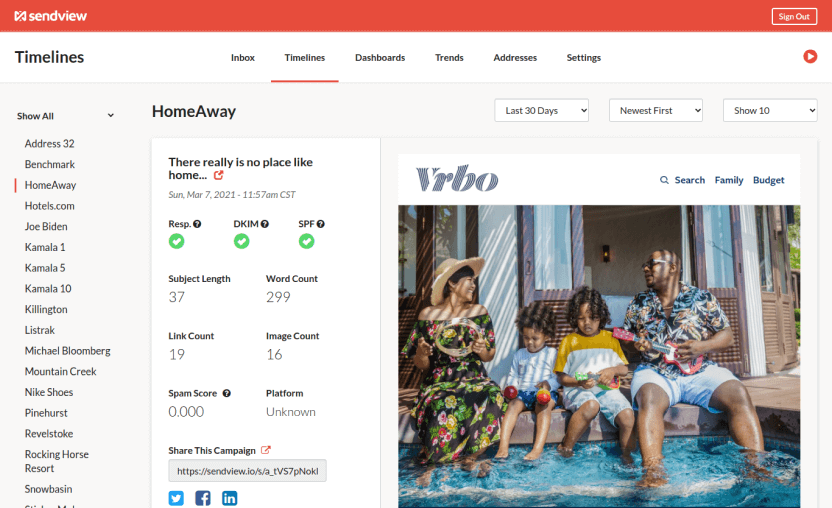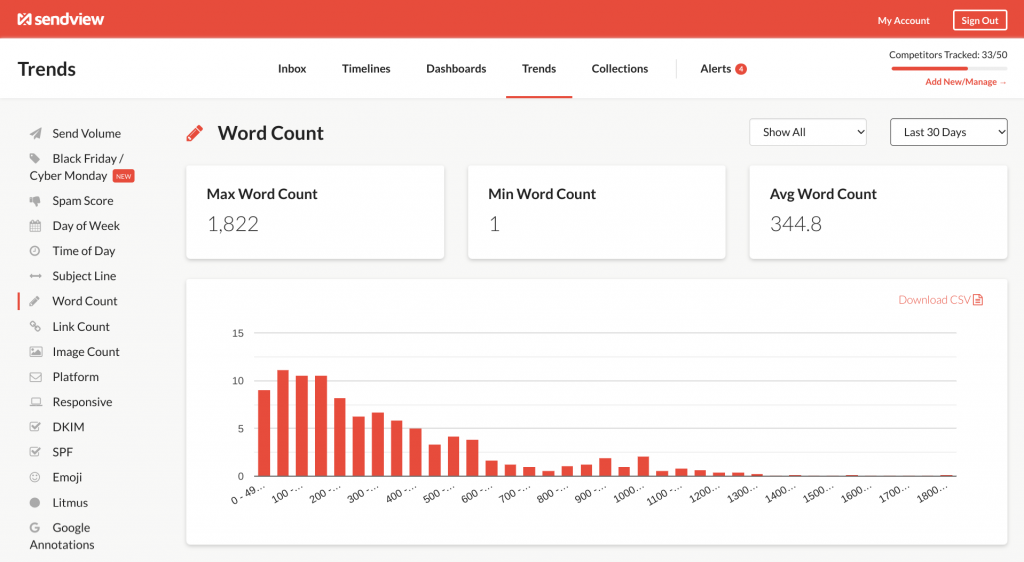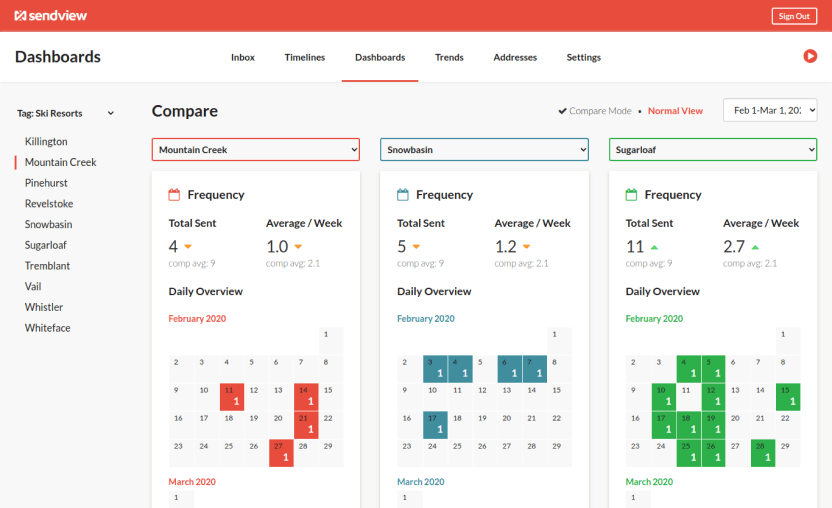If you’ve ever watched a sports movie, you’ll probably remember the team sitting down to analyze their opponent before a big game. The coaches spend hours watching previous games to find their weaknesses.
This is how they strategize to win. In email marketing, we call this competitor analysis. The definition of competitor analysis is the practice of gaining insight from competitors’ efforts. In this case, we’re talking about their email campaigns. This has historically been a hard nut to crack because most email tools like Gmail or Outlook are designed for reading emails, not analyzing them. While we've spent the last half decade building a powerful solution to competitor email monitoring called SendView, you also need to understand the hows and whys to see the value of doing these analyses.
Simply put, no matter what stage your business is in, conducting a competitive analysis can help you gain a marketing edge over your competition. In this complete guide to email marketing competitor analysis, you’ll identify your competitors, understand their email marketing tactics, and map out your brand’s strengths and weaknesses.
Ideally, your marketing strategy will help you gain more subscribers, generate CTAs that click, and reach your target conversion metrics. Without research, that’s not possible. Are you ready to level up your email marketing strategy? Let’s dive in.
What is competitor analysis?
Competitor analysis is the process of researching, analyzing, and comparing your business to other businesses in the same industry. It’s a way for you to understand how your company stands out; what makes it unique; what it does well; and what it could do better.
Sometimes also called competitive analysis, this process helps you create an effective marketing plan. Use it to identify areas of improvement, uncover untapped opportunities, and develop strategies that set your business apart from your competitors. For example, if you analyze your competitors' emails and notice that they send a big email campaign on Thursdays at 2pm ET and you have a lot of overlap with their audience, you can send your be campaign at 11am ET that same day to get ahead of that campaign and try to get those consumers to spend money with your brand before they do with your competitors.
What are the benefits of competitor analysis?
Conducting a competitor analysis allows you to get a bird’s eye view of the marketing landscape in your niche or industry. To succeed, you need to have a marketing strategy.
Creating a marketing strategy requires you to understand what your brand is already successful at and what needs to be improved, notice industry trends, and set growth targets.
Email marketing competitor analyses can reveal the following.
- The strengths and weaknesses of you and your competitors
- The landscape of your market
- Trends in your industry
- Growth benchmarks you may want to target
- Your value proposition
- Ways to stay relevant
- Ways to get more conversions
To be clear, you don't have to notice everything from every analysis. If you spot at least a couple of these insights each time you analyze your competitors' email marketing strategy you'll be on the right track.
What’s the difference between competitor analysis and competitor benchmarking?
Competitor analysis is the process of researching, analyzing, and comparing your business to other businesses in the same industry. On the other hand, competitor benchmarking measures the performance of your business against that of your competitors.
Benchmarking involves comparing key performance indicators (KPIs), such as customer satisfaction, website traffic, and email campaign performance. Benchmarking can help you set and reach realistic goals for your business when you’re creating a marketing strategy. Benchmarking can be a little tricky in the email space because typical KPis like open rate, click rate, and revenue/email aren't public like KPIs are on other channels like Facebook's like rate, Twitter/X's views, YouTube's views, etc.

That said, you can use SendView to track things like average spam score, number of email campaigns sent, etc. that you can use to benchmark against your own efforts. So in that sense, a competitor analysis effort and benchmarking program may have some overlap.
What should an email marketing competitor analysis include?
An email marketing competitor analysis should be a study of your direct competitors, their email marketing tactics, and your own strengths and weaknesses. An effective analysis will also include a plan for optimizing your own marketing strategies going forward.
Your email marketing competitor analysis should include one or more of the following.
- Side-by-side comparisons of you and your competitors
- Relevant KPIs of you and your competitors
- Competitor’s strengths
- Competitor’s weaknesses
- Feature analysis of their emails
How to find your email marketing competitors
For competitor analysis, you should focus on your direct competitors. Direct competitors should be apparent through market research, customer feedback, keyword research, or online communities. Searching for “alternatives to [your company]” may also lead to helpful results.
Your indirect competitors do offer relevant information, but what they’re doing is less likely to apply to your brand. If you don’t have many direct competitors, you can fill in some of your analysis with indirect competitors. Typically, you'll find that you have about 3-5 direct competitors in most markets that really are competing on the same level for the same audience. Analyzing their emails is most insightful, but sometimes tracking brands that are slightly up- or down-market can reveal tactics that companies like yours just aren't doing.
Not sure what the difference is? Let’s define that.
What is direct competition?
A direct competitor provides the same product or service as yours. They may even offer an option that could pass as nearly identical to yours. Customers will likely evaluate you and your direct competitors before they become a customer.
What is indirect competition?
An indirect competitor offers a product or service similar to yours but cannot solve the same problem. They may target the same audience as you or use similar marketing tactics to yours. It’s unlikely that these companies are competing for your customer’s wallet, but may garner some of their attention.
Direct competitor examples
For example, Hario and Aeropress are indirect competitors. They both offer portable coffee makers that satisfy craft coffee lovers’ home brewing needs. But, the coffee makers are engineered differently, produce a different (albeit subtle) brew, and have different durability levels. On the other hand, Hario and Chemex are direct competitors. Both of their products are pour-over coffee makers borne out of a science lab.
How to do competitor analysis in email marketing
Here are five steps to analyze your competitors’ email marketing and create a marketing strategy.
Step 1: Determine your competitors and their target audience
Before you start analyzing or creating a strategy, you need to get a lay of the land. Your direct competitors alone can reveal key information you may not have considered.
Compile this information for a high-level overview:
- Direct Competitors
- Products or services they’re offering
- Target Audience
You might want to look at their market share, pricing, and sales tactics too. Use a spreadsheet or competitor analysis template to gather this information in one place or use SendView to add notes around each competitors as you sign up to keep it all in one place. Speak of which...
Step 2: Use SendView to sign up for their newsletters
Ever wondered how to monitor your competitors’ email campaigns? We like to use a competitor tracker like SendView for this, of course. You’ll be able to see the emails they’re sending out along with insights without bloating your own email inbox.
Once you’ve identified your direct competitors, it’s time to find out what their email marketing looks like. Here’s how it works.
- Sign up for SendView
- Just add the companies you want to track to your account.
- SendView will generate a special tracking email address for each one.
- Then use that address (instead of your own) to sign up for their emails.
- Monitor the dashboards full of insights, trends, and opportunities.

Step 3: Analyze Key Elements
Once you’ve set up your SendView inbox, you can analyze the key elements of your competitor’s email strategy. Since companies send emails at regular cadences, you may have to conduct your analysis over time or wait until you have a full inbox if you’d rather do it all at once.
You can use a marketing tool like SendView to look at the emails your competitors are sending. Here are the key elements you should analyze in your competitors’ emails.
- Email design: Are they using email templates or creating custom designs?
- Email content: Check out their images, copywriting, etc.
- Calls-to-action (CTAs): How compelling are their calls to action?
- Subject lines: Are their subject lines effective?
- Mobile friendly: Is the email designed to be responsive? 62% of users open their emails on mobile.
- Cadence: How frequently are your competitors sending emails?
- Landing pages: Are their CTAs sending subscribers to landing pages?
You can also use SendView to monitor competitors’ emails and get in-depth analyses that can help you strategize more than just your email’s content. Check out these technical insights too.
- Email Service Provider (ESP)
- Spam Score
- Links
- Source Code
- Word Clouds
- Content Calendar
- Send times and days
- DomainKeys Identified Mail (DKIM) and Sender Policy Framework (SPF)
You can even experiment with SendView to see cart abandonment emails, receive both versions of their A/B testing, and get insights into how their tactics, timing, and content varies between those entry points. As you analyze your competitors' emails side-by-side, may even notice that they use one ESP for normal emails and a different ESP or tool for abandoned cart, promotions, or confirmations.

Step 4: Strategize
Now that you have a lay of the land, it’s time to strategize. Let’s create some goals and marketing tactics to effectively reach those goals.
As you track the key factors above, notice…
- Which designs and templates will suit your brand
- If there may be a better time or day to send your emails
- How you might speak to your target audience
- If there may be a better ESP for your efforts
- How you could structure your content calendar to better compete
- Which CTAs, subject lines, copy, and other content caught your eye
- How you might be able to optimize your efforts like mobile optimization
Then, create a SWOT analysis. SWOT stands for strengths, weaknesses, opportunities, and threats. Using your list of your competitors and their emails, ask yourself the following questions.
- What are my competitors’ strengths? What are they doing right?
- What are my competitors’ weaknesses, and where could they improve?
- How can I use this knowledge to improve my own efforts?
- Are my efforts in jeopardy in any way?
From these answers, you can begin to formulate a plan. To create a new strategy, you’ll need to define the following.
- New goals and key metrics for this strategy
- Aspects of your email strategy that you want to change to reach those goals
- Marketing tactics you’ll use to accomplish those changes and goals
Step 5: Test
Competitor analysis is all about finding out what everyone else is doing. But it’s essential that you remember: what works for your competitors might not work for your brand.
You can analyze and strategize as much as you want. The only way to truly optimize your email marketing efforts is through testing. A/B testing in email marketing campaigns is simply splitting a segment in half. When you’re testing, you’ll send one version of your email to one half and a different version to the other half. Then, analyze the metrics when they roll in.
A shocking 39% of brands don’t test their broadcast or segmented emails. You could have a distinct advantage over 39% of your competitors if you test. Testing reveals what works and what doesn’t so you can cater to your audience. So, once you implement your strategy, test it out! A/B testing is simple and effective with most ESPs.
Don’t underestimate it; small changes can make a difference. You can use your competitor analysis as inspiration for the changes you might want to test.
Try A/B testing these email marketing campaign attributes.
- Subject Lines
- CTAs
- Design elements like spacing or button positioning
- Content like images, gifs, and copy
- Send times and cadences
- Sender email
- Segmenting your email lists
Email marketing competitor analysis from start to finish
That’s the full guide! You can improve your email marketing strategy with the help of your competitors.
Here it is one more time from start to finish.
- Determine your competitors
- Use SendView to see their emails
- Analyze their emails and marketing tactics
- Create a strategy
- Test your strategy
What's important to keep in mind about any competitor analysis project, but especially when analyzing your competitors' emails, is that you have to have a way to not just read their emails, but explore those emails. You need an interface that's designed to tease out the tactics and trends that simply aren't visible within inboxes like Gmail or Outlook.
In other words, subscribing to your competitors' emails isn't enough. Almost all marketers at some point have subscriber to other companies' emails with the hope of keeping an eye on them. The problem is that inboxes aren't designed to let you analyze the contents. They're only designed to help you read them.
So if you want to do a true, full email marketing competitor analysis effort for your company? You need a tool like SendView.


 Gregg Blanchard January 23, 2023
Gregg Blanchard January 23, 2023